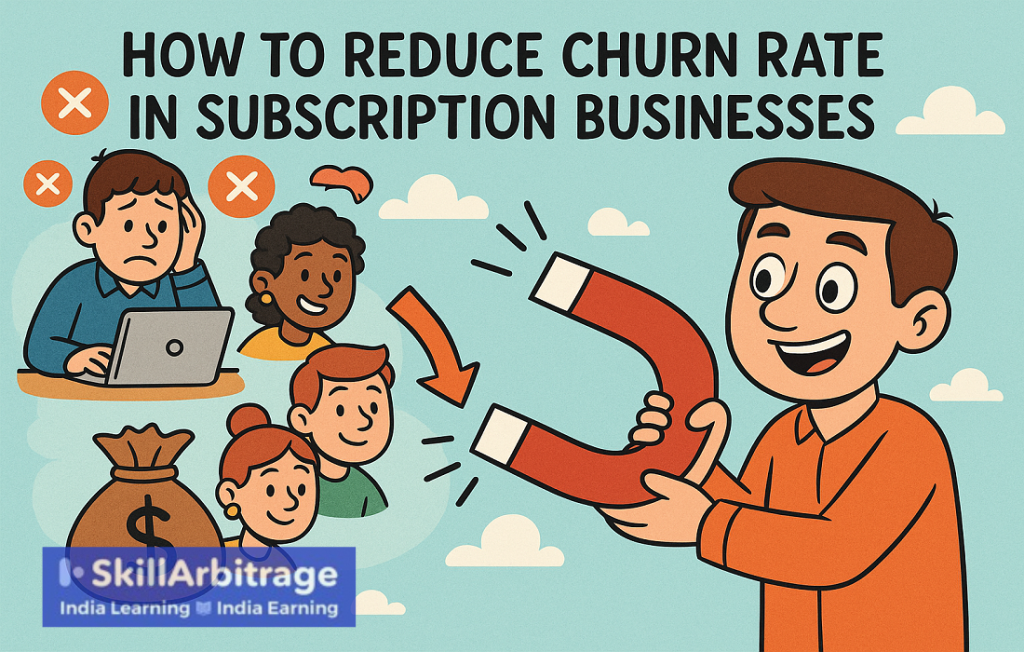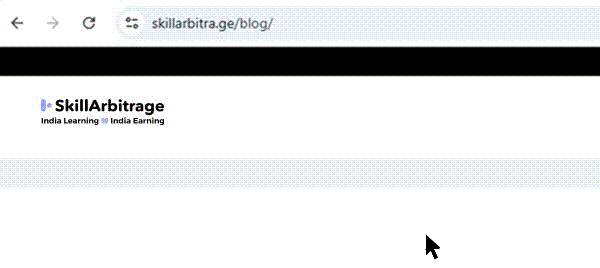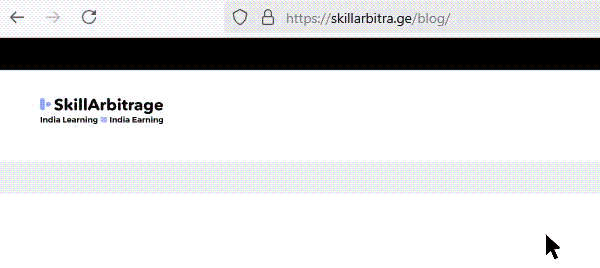This blog will show you exactly how to reduce churn in your subscription business so that your customers stay longer and you stop losing money every month.
Table of Contents
Introduction
All subscription business owners must have also experienced this feeling. You wake up in the morning, open your dashboard, and see 5 new cancellations. No warning. No feedback. Just gone. And then you sit there wondering, “What did I do wrong?”
Your morning starts with customers canceling their membership, and before you sleep, you have to wonder where to bring new customers from so that your revenue does not crash.
And what is the worst part of seeing your customers cancel? You probably didn’t do anything new to lose them. You just didn’t do enough to keep them.
Most people with subscription businesses think acquiring customers is the hard part. But what they don’t realise is, retaining customers is where the real game is. If your churn rate is high, you’ll always feel like you’re trying to fill a bucket with holes.
For those who don’t know – Churn rate is how many people stopped their subscription in a certain period of time. If 10 people had your service and 2 left, then it means your churn rate is 20%.
If you have a high churn rate, it’s not just annoying, but it is also very expensive. According to research, it costs 5 times more to acquire a new customer than to retain an existing one.
And still, most subscription businesses spend most of their time on ads, funnels, and promotions, but barely think about churn.
If you also want to fix the problem of high churn rates in your business, you are in the right place. In this blog, I’m going to show you exactly how to reduce churn rate using a step-by-step method that fixes the real reasons people leave.
But first, let’s understand how you would know if you really need to put some effort into fixing your churn rate or if yours is already good.
What’s a good churn rate?
Right now, you must be thinking about whether your churn rate is good or bad and whether you should panic. Understandable.
So, before you even learn how to fix churn rate, first find out if your churn rate is even bad or not, or else you will try fixing something that’s not even broken.
See, a good churn rate depends a lot on your business type, and it will be different for every business and industry. Here’s what that looks like for most businesses:
- SaaS, financial services businesses: Anything under 5% per month is usually good.
- E-commerce, education subscriptions: These services see higher churn, averaging around 12% monthly.
- Media, entertainment, and fitness subscriptions: These businesses usually see a 7% churn rate, so anything below it is extraordinary.
If your business doesn’t fit into one of these categories, don’t guess. Just search “[your industry] average churn rate” and see what the benchmarks look like. For example, let’ suppose you have a gaming subscription business.
So you could simply search “gaming average churn rate,” and the result will be in front of you.
With this context, you’ll know exactly where you stand and whether your churn rate actually needs fixing. If it does not need fixing, go and take a nap. But if it needs fixing, you should stop sleeping and keep your eyes glued to the screen for the next few minutes.
Now you are going to learn the main reasons why your customers are canceling their subscriptions. Because, until you don’t know the root cause, how would you treat it?
The real reason they leave
See, people cancel their subscriptions due to mostly two reasons, which are either your product/service is garbage or something that got broken during their membership.
The first case is loud, so if that were the case, you would get messages from your customers for sure. But in the second case, it’s mostly silent. You don’t even see them coming, and all of a sudden, people stop paying.
Here are a few reasons why people quit, even if they don’t dislike what you sell:
- They stopped using it for a few days and forgot it existed, so they never came back. Life got busy, so they missed a few logins, and suddenly, it just felt easier to cancel than to catch up.
- They didn’t fully understand how to use it. So they thought it was not for them, even if it was.
- They got stuck and confused somewhere, and it was not easy for them to find support or guidance, so they considered leaving quietly rather than asking.
- They forgot why it mattered that they joined in the first place. They were not able to remember what the value proposition was and what advantage they would have by staying inside. So, they thought it was just not very valuable, even if it may be.
- They felt like it was just another payment and not a person they paid for. If you stop showing up after the sale, they’ll feel ignored. And ignored customers don’t stick around.
- Or worse, they saw a competitor, and you weren’t there to remind them why you’re better. You never got to defend your value because you went silent.
These are just a few reasons, but these will help you understand what the matter is. You might have understood by now what the concept behind people unsubscribing is. The problem is not dislike, instead it’s disconnection.
And if you want to reduce churn, you don’t need to rebuild your whole product. You just need to fix the small moments where people quietly leave. Let’s do that now.
A step-by-step method to reduce the churn rate in your subscription business
Before we jump into the steps, just remember that reducing churn doesn’t mean throwing 10 ideas at the wall and hoping a customer might continue their subscription due to any of it.
Most businesses try a bunch of tactics to reduce churn rate without even knowing what’s causing the churn. Make sure you don’t do that.
You’re going to fix churn the right way. One step at a time. First, you find what’s broken, then you fix it, and then you lock in the customers who already love you. That’s how real progress happens. Let’s start by understanding the root cause of our problem.
Step 1: Identify why customers are leaving
You cannot fix a leak if you don’t know where it is. Agree with the statement? Then you will also agree that before you even think about fixing churn, you need to understand why people are leaving in the first place.
That is what most people don’t do. They start guessing why people are leaving. They assume the pricing is too high. Or that people didn’t like the product. But guessing won’t help. You need real answers from real users.
Here are a few ways you can get real answers on why customers are leaving:
- An exit survey
Nothing complicated. Simply create a survey form with one simple question – “What’s the main reason you decided to cancel your subscription? Your response will remain anonymous.” Then send this form to everyone who cancels.
Give them an open-ended box so that they can type their answers. The line where the question will be saying that the answers are anonymous will give people freedom to be honest with their answers, as they know nobody will be judging.
Make sure the form is simple and short, with nothing that will distract the user, so that it brings you direct, honest feedback from people at the moment they leave.
- Support tickets
Pull up your support conversations, whether emails, chat logs, or helpdesk tickets. Now, start scanning for repeated complaints or questions.
If something keeps coming up again and again, then fix it, as it’s not just a product/service issue but it’s also a churn risk.
When people get stuck or confused and can’t figure out what to do next, they quietly drop off. They don’t always tell you. They just stop showing up and eventually cancel.
But some of them mention it at the helpdesk, and that’s why it is your goldmine. Spot the patterns and write them down. This will directly tell you what’s making people leave, even if they never say it out loud.
- Talk to your best users
Reach out to those customers who have stayed with you for the longest period of time and ask them one simple question – “What made you stay with us?”
No need to overthink this. Simply ask them this on whatever channel feels natural: email, WhatsApp, or DMs.
You’ll be surprised how clear the answers are. They’ll tell you what they love, what’s actually working, and why they chose to stick around when others didn’t. And when you compare this with why people are leaving, you’ll start seeing the gap.
Your goal in this step is not just to collect random feedback but to try to spot patterns. Once you know the top 1-2 reasons people are canceling, you’ll have a clear target on what to fix. And that’s when you move to step 2 where you will fix it.
Step 2: Fix the top reason for churn
Now that you know the top reasons why people are canceling, don’t try to fix all of them at once because that will be a waste of your energy, and it will scatter your efforts. You just need to fix the biggest reason first. Why?
Because most of your churn is usually caused by just one or two core issues. Solving just them can give you an instant huge drop in cancellations. Then the smaller issues will start to disappear or you can then try fixing them after the biggest ones.
Here’s how you can handle the most common ones that most businesses face:
- “Your prices are too high”
If people are saying that your prices are too high, then it does not mean you should directly jump towards giving discounts. Why? Because price is determined on the basis of value.
If you get a car for Rs 1000, you will rush to buy it, but if you are getting a chocolate for Rs 1000, it will feel costly. So, it’s not about the price but it’s about the value.
The problem is that people are not feeling that your product/service is worth the price. So, what you can do is simply show the value they get more clearly, decrease the price so it matches the value, or increase the value they get.
- “I did not understand how to use it”
If people are saying that they were confused or didn’t know how to use the product/service, then in most cases, that’s not a product problem but it’s an onboarding problem.
You can have the best product in the world, but if users don’t know how to use it or where to start, they won’t use it. So, your goal is simply to help them get value as quickly as possible by easily being able to use the product/service.
That means you need to create a short walkthrough, a quick-start guide, or even send a welcome email that shows them the first step to take and how to use the product/service.
- “It had bugs / poor support / missing features”
If people are canceling because of bugs, bad support, or missing features, then you already know what to do. I don’t need to tell you again.
Go ahead and fix the bugs. Don’t let small technical issues become big churn reasons.
Go ahead and tighten your support. If users don’t feel helped when they’re stuck, they’ll leave quietly.
And if a feature is being requested again and again, add it. If it’s coming up often, then it means clearly that feature matters to your users.
These are not complicated problems. You just need to stop delaying and start solving them.
- “I forgot about it & never used it”
If users are saying they forgot to even use your product or service then the problem is that you’re not staying in touch. People are busy, so if you disappear after the sale, then they will disappear too.
So what you need to do is show up regularly by sending them reminder emails, sharing helpful updates, small tips, or even simple nudges that help them remember to use it.
You don’t need to be pushy. Your goal is just to stay visible. Because if they forget you exist and they never use it, then it means the product did not add any value in their life, hence they’ll cancel without thinking twice.
- “I didn’t have time”
If people are saying that they didn’t have time to use your product or service, what they’re actually saying is that it felt like too much effort, and they did not feel it was worth their time.
So, your goal is to simplify the process. Trim the steps involved in getting value out of the product/service. Remove the extra clicks to eliminate friction. Hence, make it easy to get value in 5 minutes, not 50.
- “It didn’t feel like it was for me”
If users are saying the product didn’t feel right for them, then your positioning is off. It means either your messaging was too generic or the experience didn’t match what people expected before joining.
Maybe it felt too basic or too advanced to them. Whatever it was, your job now is to re-analyse who you’re actually selling to and start speaking their language. Show examples that match their situation. They should feel it was made just for them.
These are the usual suspects. Most churn issues fall into one of these buckets. But what if yours doesn’t? Not a problem. The rule remains the same. Fix the biggest blocker that’s making people leave.
And once you have fixed the biggest reasons for churn in your business, you can then move on to fixing the whole experience of being your customer so that in each step, they feel delighted and in each step, they remember they must renew.
Step 3: Have the best onboarding experience
See, if you don’t know, let me tell you that most users don’t make their decision to quit at the end of the time period, but they make it in the first few days itself. In fact, over 80% of churn happens within the first 30 days.
That’s a big number so if your onboarding sucks, your customers are already halfway out the door before they even get started. So the goal you should have during your onboarding is to get users to their first “aha moment” as fast as possible.
The moment when they feel the value and say, “Oh, this is actually useful. I should have found this earlier.” And here’s how you can make that happen:
- Emails that guide instead of overload
When someone joins your subscription, instead of overloading them with excessive information or no information, you need to carefully think of what to really send.
Your focus should be on sending concise emails once every week or month that tell the user to take one action at a time, which could help them understand and utilize the product/service much better.
This way, the user will stay connected and learn about your product/service slowly, one at a time, instead of getting overwhelmed with a 100-page guide bombarded on them.
- Tooltips, checklists, and small nudges
Once a user onboards, they shouldn’t be left wondering what and how to do it next. That’s where in-app guidance comes in. Simple things like tooltips, progress checklists, or small popups can guide the user without them needing to ask for help.
It removes the hesitation and keeps them moving forward inside your product. The less they have to think, the easier it is for them to enjoy your product/service. And when they find more value, they stick around more.
- A short tutorial video or welcome screen
When someone logs in for the first time, don’t leave them staring at a blank screen or a cluttered dashboard, wondering where to start. Show them clearly what to do.
Show them a simple welcome screen or a short 2-minute tutorial video, as it will help the user understand how to start using your product/service without getting lost.
- Remove dead ends and confusing spots
While using your product/service, if a user hits a point where they don’t know what to do next, they’ll stop right there and most likely won’t come back, thinking it’s not for them.
So your job is to make sure the journey inside your product or service feels smooth and clear from the start. Go through the full experience yourself and look for anything that feels stuck, slow, or confusing, then fix it.
Remove steps that don’t need to be there. Add small hints where users might get lost. Clean up anything that feels clunky. Your users getting a smooth first experience will build confidence, and confident users are the ones who stay.
The truth is that if someone doesn’t get value in their first week, they won’t stick around. So don’t leave onboarding as an afterthought because that is where churn begins, and it is the same place where you can stop it before it starts.
But what if users get an awesome onboarding experience, but in between their membership, they decide to cancel for some reason? Don’t you think it will be better if you can spot them early and do something so that they stay?
Step 4: Spot the signs and save the user
Most businesses wait until it’s too late to make the user change their decision. They only notice churn when the user actually clicks “cancel,” but what they don’t understand is that the user had made the decision to cancel way early.
Your job is to spot the danger signs early, which will show you if a user intends to cancel anytime soon. That’s what we call churn-prevention triggers. These are internal alerts you can set up to catch risky behavior immediately. For example:
- No logins for 7+ days – Users have gone quiet, which is a red flag.
- Less usage – They used to be active now they’re barely using it.
- They visited the cancellation page – They’re clearly thinking about leaving, but something made them wait.
- They stopped using key features – Maybe they forgot, got stuck, or lost interest.
These signals will help you predict churn before it happens so that you can use them to your advantage and take action fast to save the users. Here’s what you can do:
- Send a short personal message saying, “Hey, we noticed you haven’t logged in lately. Anything we can help with?”
- Offer a quick support call or free check-in to solve whatever is holding them back.
- Share a short tip, helpful video, or mini tutorial to get them re-engaged.
This step matters a lot because it gives you a second chance to save users before they even start getting the thoughts to cancel. And once you set these triggers up, they’ll run in the background forever, helping you quietly catch churn risks and give time to win them back.
This one step alone can help you recover users you would’ve otherwise lost for good. But these are for fixes that you need for problems. What about those businesses that are not facing problems? How would they fix churn?
Step 5: Give them reasons to stay
Till now, you were reacting to things that made people cancel and fixing them. Those are your defences. Now it’s time for your offenses. Instead of just trying to remove bad stuff and fixing problems to make people stay, you should start giving them hard-core reasons to stay.
But how, and what reasons to give? Here are a few simple ways that work with most businesses. You could copy these or think of something that will be relevant for your particular business.
- Loyalty rewards
In addition to users enjoying your product/service, give extra rewards to those users who opt in for the longer duration plan or renew their memberships month after month. For example: “Get 1 month free after 3 months.”
You don’t need to give them something that costs a lot. Anything “extra” will just seem like a big win for them, even if it’s small. These rewards will make people feel appreciated and also motivated to show loyalty to you.
- Loudly announce updates
Whenever you roll out a new feature or improvement, don’t just publish it quietly in a changelog or settings page; instead, announce it properly and loudly so that everybody knows about it.
Let people be updated with what’s new, how it helps them, and why it makes their experience better. Use all communication channels possible, like emails, in-app messages, or even a simple update post to highlight it.
This shows users that your product is growing, improving, and becoming more valuable over time. And when people see regular progress, they’re more likely to stick around because they feel like they’re part of something that is getting better.
This step matters because retention isn’t just about fixing problems but it’s also about building attachment. When users feel like they’re getting more if they stay for longer, they’re less likely to even think about canceling.
Make them feel like leaving would mean missing out on something that others will enjoy. That’s how you make your product not just useful but also something worth holding on to.
Now, you have avoided churn at all possible steps and in all possible ways, but you should never give up. If any user goes through all these fences and still tries to cancel, you can make one last try.
Step 6: Make it hard to leave
You’ve already worked hard to bring the user in and make them stay. So now your job is simply to not let them leave easily, at least without trying your best to make them stay even after they went to the cancellation button.
This is because that is the last stage where you can try. Once they are out, it will be very hard to bring them back. So you should definitely give your best in this step. Here’s how you can bring them back even from the cancellation button:
- Let users pause
Sometimes, users don’t want to cancel; instead, they just want to take a small break. Yes, they will come back after a 1-2 month break, but we should not let them go, as who knows if they change their mind later or go for a competitor.
So, just give them an easy option to pause their subscription instead of canceling. It will give them breathing room while still keeping them connected to you.
- Let users downgrade
Not every user cancels because they hate your product, but some just feel they’re not using it enough to justify the full price.
So, instead of making them choose between all or nothing, give them a smaller, cheaper plan that they can downgrade to.
This way, they don’t have to leave completely and still stay in your system, stay connected, to maybe upgrade again in the future when their needs grow.
- Exit survey + save offer
When someone clicks the cancel button, don’t just let them leave silently. That’s your last chance to understand why they’re leaving and maybe stop them. If they don’t stop, it will at least help you know the reasons so that you can fix it.
So, show them a short exit survey and ask them one simple question – “What’s the main reason you’re canceling?” Then, based on their answer, offer them something relevant that might change their mind.
This one small step can save a surprising number of users who were on the fence and would’ve stayed if they were just given a reason to reconsider.
- Remind users
Before someone cancels, give them a quick reminder of everything they’ll lose access to. All the features, saved data, support, community, or anything exclusive they currently enjoy.
This isn’t to scare them, but it’s just a reality check that shows what they’re about to give up. Sometimes, people cancel without thinking it through. A quick reminder helps them pause and reconsider before they hit that final button.
- Help me decide
Some users don’t really want to cancel instead, they’re just confused, stuck, or not sure what plan fits them best. So, instead of sending them straight to the cancel page, add a small “Help me decide” button.
Clicking it can open a short quiz or even a live chat where a support executive or chatbot guides them to a better plan or offer support. It gives you a chance to step in before they leave.
Make sure that in this process, you don’t end up making the cancellation process shady. Some businesses just hide the cancel button somewhere deep down in the ocean so that it is a tedious task to cancel.
Customers are smart, and once they realise what the business is trying to do, it puts a huge dent in their trust. Be honest, be clear, and just give people a reason to think twice before leaving. Your goal is not to trick them but just to remind them there’s still value here.
Conclusion
I’ve now shown you everything you need to know to build a proper churn-reduction system inside your subscription business and say goodbye to high churn forever. Now it’s your turn to actually use these steps and make sure your customers don’t leave.
Do that and you’ll not just stop churn, you’ll start growing faster without needing new customers every day. Let me know your experiences on how it was. And if you need to learn how to price your product/service the right way, you can learn it by clicking here.
FAQS
- What if users cancel but don’t fill out the exit survey?
That’ll happen. Most people won’t bother unless the form is dead simple. Keep it short, one question max, and mention, “Your feedback helps us improve.” You can also offer a small thank you gift, like a discount or freebie, if they fill it out.
- How many days of inactivity should I use as a warning sign?
Depends on your business. For daily-use products, 3-5 days of no activity is a red flag. For weekly tools, 7-10 days. Look at your average usage data and set the trigger when people usually start dropping off.
- Should I offer discounts to stop the churn?
Only if it’s the right reason. Don’t discount just to keep everyone. But if someone is leaving due to price and they’re a good-fit customer, a discount or lower-tier plan can make sense. Always try to fix the value first, then talk price.
- What if I don’t know how to measure the churn rate?
Basic version: (Number of customers who canceled ÷ Total customers at start of month) × 100. That gives you your monthly churn percentage. Keep tracking that number every month like your life depends on it.
- What if I can’t afford to give loyalty rewards or discounts?
No problem. Loyalty doesn’t have to cost money. Even something like a “member spotlight,” early access to new features, or a simple thank-you message after 3 months can do wonders. People just want to feel noticed.







 Allow notifications
Allow notifications
